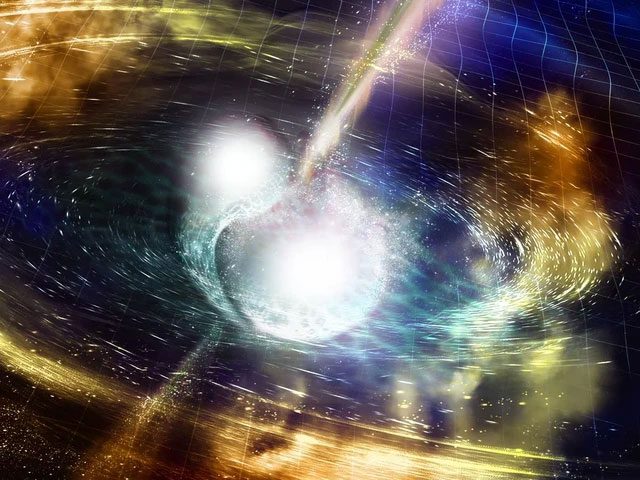The origins and shocking nature of a “bombardment” signal from a location 130 million light-years away from Earth have just been successfully decoded by scientists.
A team of researchers led by the Max Planck Institute for Gravitational Physics and the University of Potsdam (Germany) utilized advanced software to analyze the signal detected from the explosive event known as GW170817.
According to Space.com, GW170817 was first identified through a puzzling signal in 2017. It has since been confirmed as a kilonova resulting from a neutron star collision 130 million light-years away.

“Double Zombie” created by colliding neutron stars – (Graphic: LIGO/NSF).
Neutron stars can be described as the most terrifying kind of “zombie” in the universe. The strongest neutron stars possess magnetic fields millions of times stronger than Earth’s, despite their diameters being roughly the size of a grapefruit to that of a city.
They are the remnants of gigantic stars that have undergone a “death” process. Although they are dead, they remain active, emitting powerful energy, which is why they are compared to zombies.
Moreover, the horror escalates when these neutron stars collide and merge. They can explode into a phenomenon known as a “kilonova”, which is over a thousand times more powerful than a supernova (the explosive death of a star).
New research indicates that GW170817 could provide answers to a puzzle that scientists have long sought: What is powerful enough to forge heavy elements such as gold, platinum, or uranium?
According to the widely accepted theory of cosmic chemical evolution, the early universe following the Big Bang was quite monotonous, consisting only of the lightest elements like hydrogen and helium.
Stars that formed subsequently forged heavier elements within their cores. Then, upon dying and becoming supernovae, they expelled these heavier elements into space.
New generations of stars formed from that richer material, continuing to forge even heavier elements. As a result, we have a relatively long chemical periodic table today.
However, the heaviest elements like gold, platinum, and uranium seem to require a stronger “forge”. The recently identified kilonova may indeed be the “forge” that scientists have been searching for.
When neutron stars collide, jets of neutron-rich material are ejected into space. This creates an environment rich in free neutrons.
Other atoms in the universe quickly capture these free neutrons, combining with them to create very heavy elements, heavier than anything currently present on our periodic table.
Nevertheless, these elements are often unstable, rapidly decaying into lighter elements such as gold, platinum, and uranium.
In other words, the jets of material emitted by the “double zombie” underwent two transformations to become gold, platinum, and uranium, and this process generates the brilliant light of supernovae, as well as the extremely strong radio signals that can be detected even from Earth, located at such a great distance.


















































